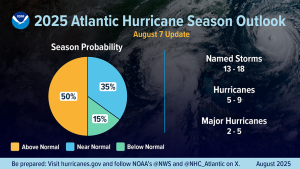Hurricane Landscaping
Be ready for hurricane season. The Atlantic hurricane season lasts from June 1 to November 30. August and September are generally the most active months.
The season is expected to be above normal – due to a combination of factors, including warmer-than-average sea surface temperatures in the tropical Atlantic Ocean and Caribbean Seas, and an active West African Monsoon. ENSO-neutral conditions are expected to continue, meaning there is neither an El Nino nor La Nina to influence this season’s storm activity. Read the full statement on NOAA’s website.
One thing you can do now to protect your family and home is to hurricane-proof your landscape. Here are some tips to help you get started:
Right Tree, Right Place – Choose trees that are well-suited for your landscape. Plant larger trees away from your home, power lines, and other structures. This reduces the risk of branches—or trees—falling on your home. It also prevents them from knocking down power lines.
Choose Wind-resistant Species – Some trees are more wind-resistant than others. Suggested wind-resistant varieties include sabal palms, crapemyrtle,. Gumbo limbo, live oak, and sea grape also have high hurricane survival rates.

Regular Pruning and Maintenance –Regular pruning has several benefits. It promotes healthy growth and removes dead, dying, or diseased limbs. Assess trees, paying close attention to the branches. Remove limbs that are dying, damaged, or weakly connected to the trunk. Thinning or reducing the crown can reduce trunk movement during a hurricane. You can also prune to reshape the tree. When done correctly, reshaping can make trees more resistant to wind damage. If branches are large or high in the tree, seek help. It’s best to hire a certified arborist to prune.
Planting in Groups or Masses – Planting groups of mixed trees together can greatly enhance wind resistance. The trees buffer each other as well as your property and landscape plants. However, recent research suggests we’re not planting trees close enough to each other.
Protecting Stormwater Systems – Storm drains and gutters can easily become clogged with debris. Protect storm drains – do not blow or rake leaves or grass clippings into drains. Make sure gutters are securely attached, pointed away from your home, and are cleared of debris. You can also prevent soil erosion by placing pavers in areas that are prone to runoff.
What to do When a Hurricane is Coming
Once you know there is a hurricane heading your way, there are some steps you should take to protect your landscape:

Secure Objects – Container plants, hanging baskets, yard art, patio furniture, and any other loose objects need to be moved to a sheltered area. If plants are too heavy to move, lay them flat between a hedge and your home’s foundation.
Turn Off Irrigation Systems – Your plants will have plenty of water during the hurricane, so irrigation is unnecessary.
Prepare Rain Barrels – If your rain barrels are empty, move them to a secure location. If they are connected to a gutter, disconnect them and allow them to overflow from the top. If there is already a significant amount of water in the barrels, fill them up the rest of the way they are less likely to blow away.
Post-hurricane Tasks
After a hurricane, remember that your landscape needs to be maintained. Identify any potential hazards, such as debris or branches near power lines, lifted roots that may affect underground utilities or irrigation, or leaning trees and hanging limbs. Call your utility company to report any outages or downed lines. Damaged trees need to be removed or restored; start by trimming small broken branches, if you can. Then, take care of any fallen debris in your yard.
Be sure to check out our Trees and Hurricanes website. This resource provides detailed information on storm damage prevention and treatment. (Disponible en Español)
Also on Gardening Solutions
- Cleaning Up After A Hurricane
- Preparing Trees for Hurricanes
- Restoring Trees After a Storm
- Tree Risk Assessment
- Trees That Can Withstand Hurricanes
More from UF/IFAS
- How to Minimize Damage in the Florida Landscape
- Is your landscape ready for a major storm? UF experts provide top tips to maintain a resilient landscape–UF/IFAS News
- Selecting Coastal Plain Species for Wind Resistance
- Selecting Tropical and Subtropical Tree Species for Wind Resistance

